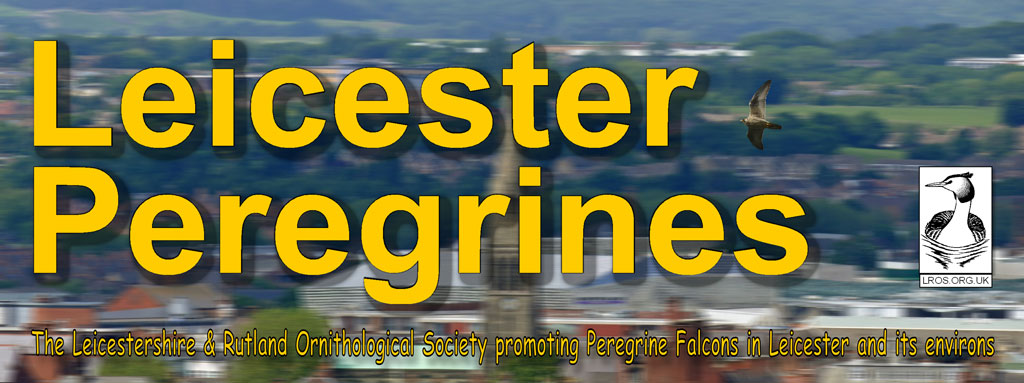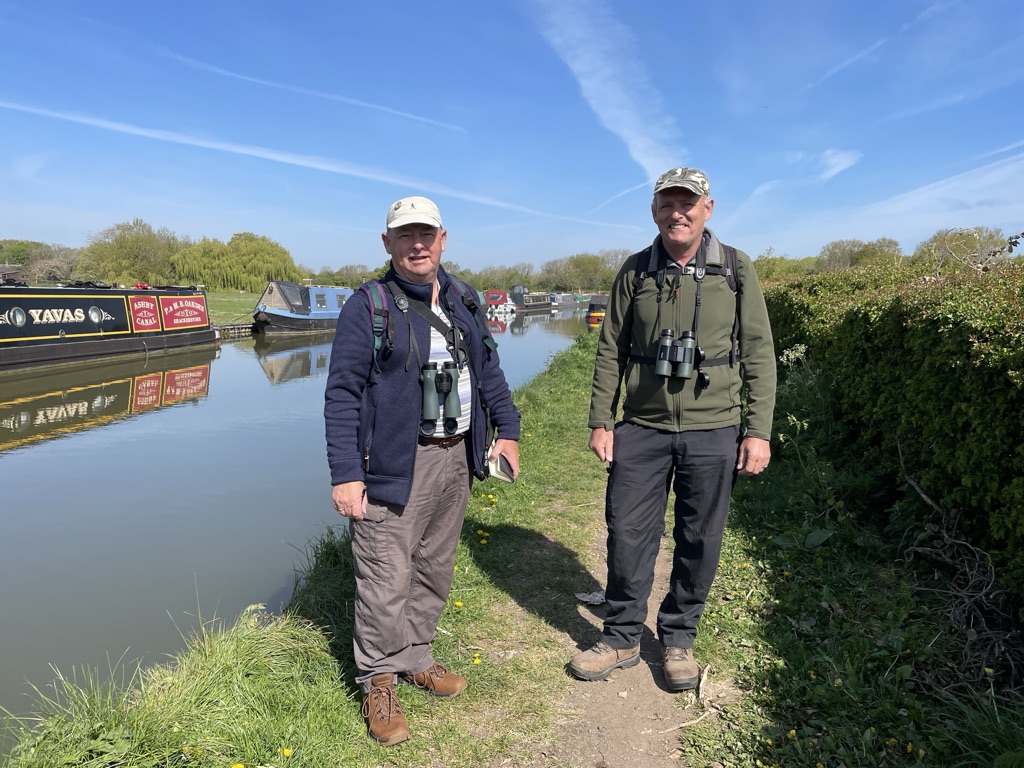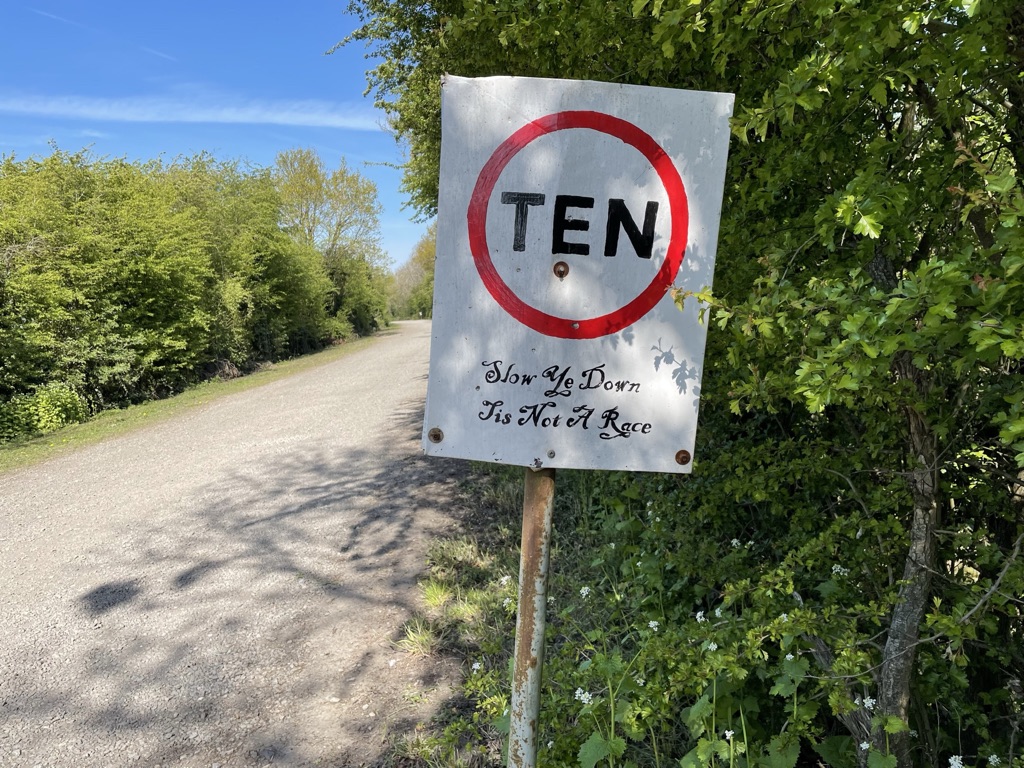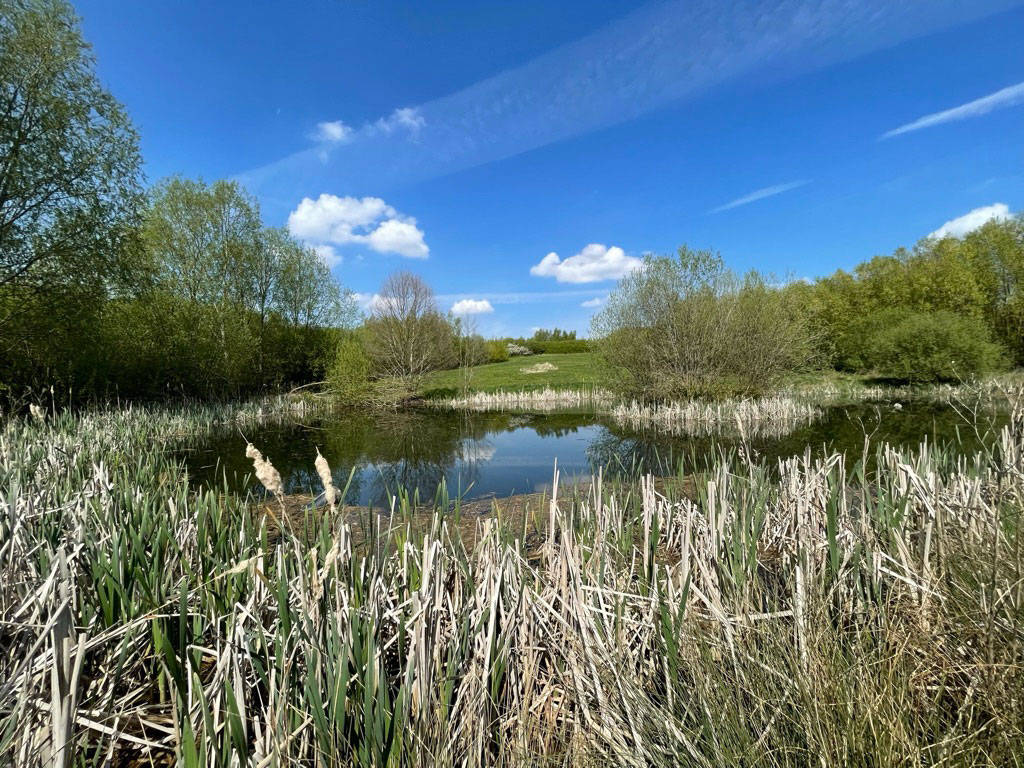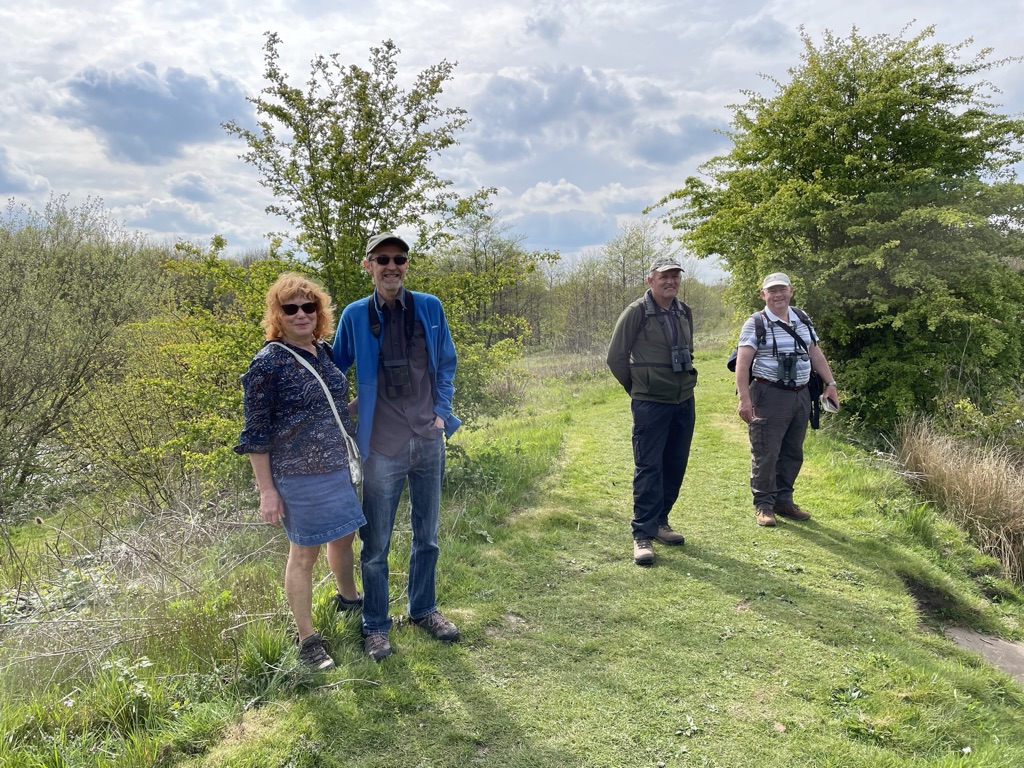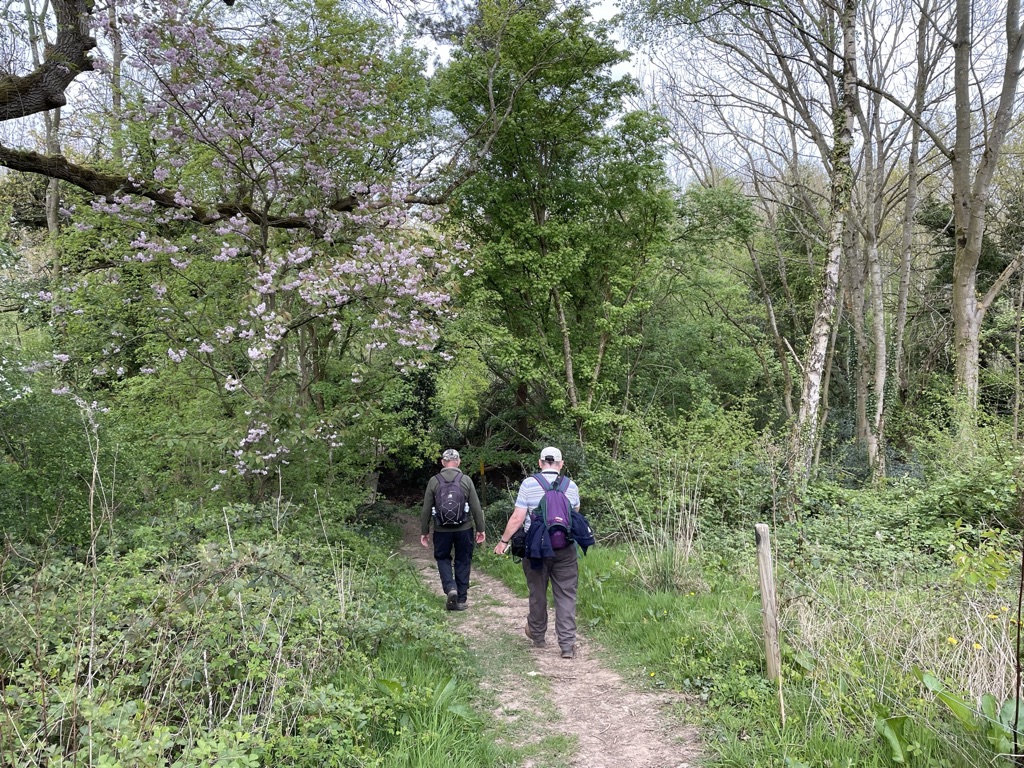Birding the Leicestershire Round
Section 10 : Shackerstone to Newtown Linford, Saturday 30th April 2022
Participants: Jim, Sue, Andrew. Dave and Julie met us at Bagworth and Andy at Thornton Reservoir for a short stretch each. Iain was our wonderful chauffeur who got us to our starting point and joined us and Josh in the pub at the end of the Round for the final celebrations.
The bitterly cold north-east wind which had challenged our senses on the much of the Round so far had finally given way to milder air, beautiful blue skies and sunshine as we set off for the final leg of our journey through Leicestershire. We met Andrew, already scanning Shackerstone churchyard, and began our list with a familiar array of House Sparrow, Greenfinch, Blackbird, Starling, Robin and Woodpigeon. We lingered here a while to observe a Stock Dove nesting in the Church, several House Martin and a Buzzard spiralling overhead before moving down to the canal to begin our walk. The usual disorientation ensued while we tried to fathom out which way we should be heading, until Andrew spotted a barely discernible Leicestershire Round sticker, worn and blackened against the black background of the signpost, giving some reassurance at least, that we had chosen the right direction!
Looking across the canal to the mound where a Motte and Bailey castle once stood, Mallard, Coot and Canada Goose occupied the various stretches of water. Many narrow boats were moored here, bedecked with flowers, castle and rose ornaments and bearing a variety of intriguing and amusing names. The faint sound of a steam train could be heard chugging along in the distance, another reminder of a bygone age, still thankfully clinging on in this exquisite part of the County.
A Whitethroat song-flighted along the hedge and a Great Tit sang loudly as our path then left the canal to cross delightful fields of natural grassland and mature hedgerows to a disused branch of the railway line. By a small footbridge, we picked up Mandarin Duck, Little Egret, Wren, Goldcrest, Dunnock and Blackcap. Further along, in a field of Oilseed Rape, we spotted a Hare in the middle of the track and Red-legged Partridge.
Butterflies were active in the warm sunshine and several Small Tortoisehell, Brimstone, Peacock, Orange-tip and Small White were observed flitting across the fields.
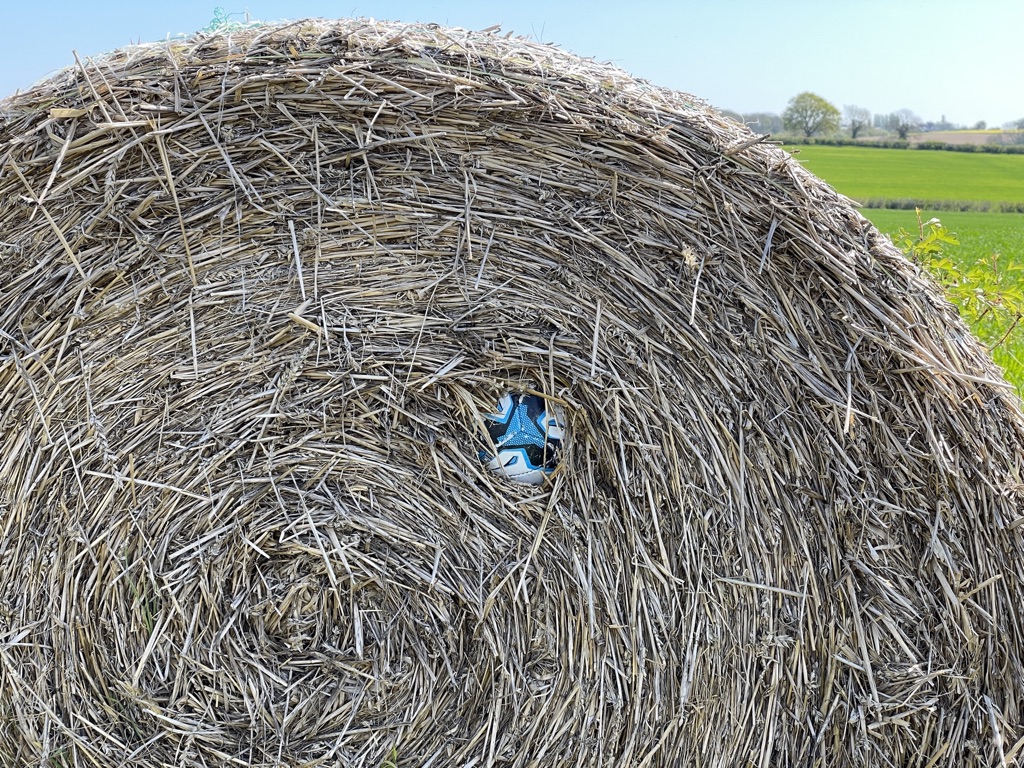
As we scanned the landscape between Top House and Odstone Hall, Jim spotted a new bird for the Round – a circling Hobby! We were just celebrating this find when a Buzzard shot out of a tree in front of us and climbed the thermals to join a spiral of seven more, high up in the sky. Skylarks were ramping up into full song as we approached Oddstone village and we added more wheezing Greenfinch plus Chaffinch, Goldfinch, Blue Tit, Linnet, Song Thrush, Swallow and Pied Wagtail to our list for the day. Several Starling were nesting in the house gutterings and there was much spring activity amongst humans here too, with nearly every house undertaking some sort of building works to their houses, driveways and gardens.
Our route then followed Oddstone Road before branching off left across the fields and over a green lane towards Nailstone. We passed the southern tip of Nailstone Gorse – a dense woodland bordered by a pink margin of Red Campion and containing a small pond. A huge splash of a fish caught our attention, but no birds were seen here despite our wishful yearning for a Kingfisher.
The next stretch of path took us through the middle of a vast field of Oilseed Rape, some six feet in height. The heady scent became quite intense as we pushed our way through to Ibstock Road, emerging with yellow, pollen-laden clothes and boots. A Reed Bunting and Kestrel were welcome addition to our list here, together with more singing Skylarks. A Holly Blue butterfly flitted amongst the vegetation as we arrived at Nailstone, where the usual chorus of species accompanied us through the churchyard. A rather affectionate grey cat adopted us on our way through the gravestones but soon lost interest when we ignored it in favour of the birds!
We then crossed a number of finely drilled, dry and dusty fields, the margins of which played host to Yellowhammer and large numbers of St Mark’s (Hawthorn) Fly, but otherwise barren until we got to Underhills Wood. We were feeling peckish by now, so resolved to stop here for our lunch.
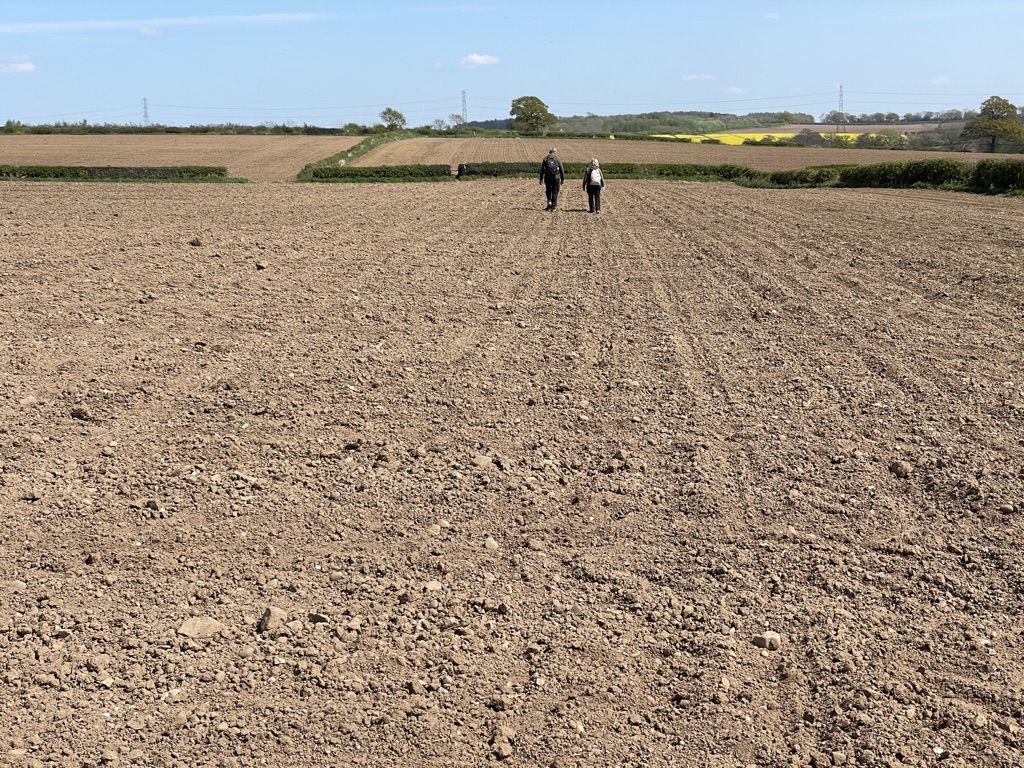
Finding a secluded little pond bordered by Bullrushes off the beaten track, we rested awhile and enjoyed our refreshments while two Canada Geese paraded up and down the water.
The songs and calls of Willow Warbler, Chiffchaff, Blackcap and Long-tailed Tit surrounded us as we soaked up the sunshine but knowing that we still had some miles to cover, we couldn’t linger for too long and were soon on our way again through the woods, marked as belonging to the 2006 National Forest Tender Scheme. We were saddened to find a dead fox here, looking in absolutely pristine condition, until we discovered the tell-tale sign of a single bullet wound to the head. The animal appeared to have been shot down mid-leap, perhaps for ‘sport’ or misguided ‘control’. Either way, it was disturbing to witness how this once beautiful animal had had its life extinguished in a second by someone whose sympathies did not align with Nature.
We emerged from the wood and ascended the hill to discover that our ‘secluded’ little picnic spot by the pond was now in full view, complete with seat and panoramic scenes across the surrounding countryside, which would have made an equally satisfying stop, had we have known that it was there beforehand! Further along, the holes of a large Badger’s sett were discovered right beside the footpath, extending several metres along the hedgerow. Eventually, we arrived in Bagworth and made our way through the centre to Bagworth Woods, noting Swallow, Whitethroat and Lesser Whitethroat along the way. Freshly emerged Bluebells and Primroses at the start of the woods provided a stunning tapestry of violet-blue and gold and we also glimpsed of a Muntjac deer, which immediately melted into the thicket, never to be seen again.
A cheery prospect awaited us on our arrival at Bagworth Wood and lakes, where we met up with Dave and Julie on a minor detour via the Sand Martin Wall. Twenty plus Sand Martins rose into the air from the wall as we arrived. Initially we thought that we had disturbed them, but the cause later transpired to be a male Sparrowhawk, which had buried itself deep into the bushes, awaiting its next opportunity for a surprise attack. Dave pointed out that this was also a good area for Dingy Skipper and various dragonflies, but the cold weather had thus far delayed their emergence. We walked together for a while, scouring the lakes and woods for any new birds but to no avail. A Moorhen with six chicks however kept us entertained and other species in the vicinity included Lesser Black-backed Gull, Mallard, Goldcrest, Long-tailed Titi, Willow Warbler, Whitethroat and Blackcap.
We returned to the ‘official’ path, and followed the track out of the woods, over the railway line and down to Thornton Mill, noting Cormorant, Stock Dove, Kestrel, Goldfinch, Greenfinch, Magpie, House Sparrow and Rabbit on the way. Here we said our goodbyes to Dave and Julie and climbed up through Thornton village before descending once more to Thornton Reservoir to meet up with Andy. We had previously put our order in for Little Grebe which had so far proved elusive on the Round, despite passing by numerous candidate lakes and ponds. Andy duly obliged and two minutes after arriving at the western arm of the reservoir we heard the characteristic trills of three Little Grebes in full summer plumage, diving and preening in front of us. At last – another new bird for the Round! We were not so lucky with our pre-ordered Spotted Flycatcher, Reed and Sedge Warbler, Grey Partridge and Cuckoo, with Andy muttering some feeble excuse about them being held up by the north-easterly winds to date. His early morning sightings of a Ringed Plover and Common Sandpiper on the Dam did nothing to appease us either, but we did have some lovely views of nesting Mute Swan, Coot and Moorhen, together with Great Crested Grebe, Mallard and Tufted Duck further out on the water.
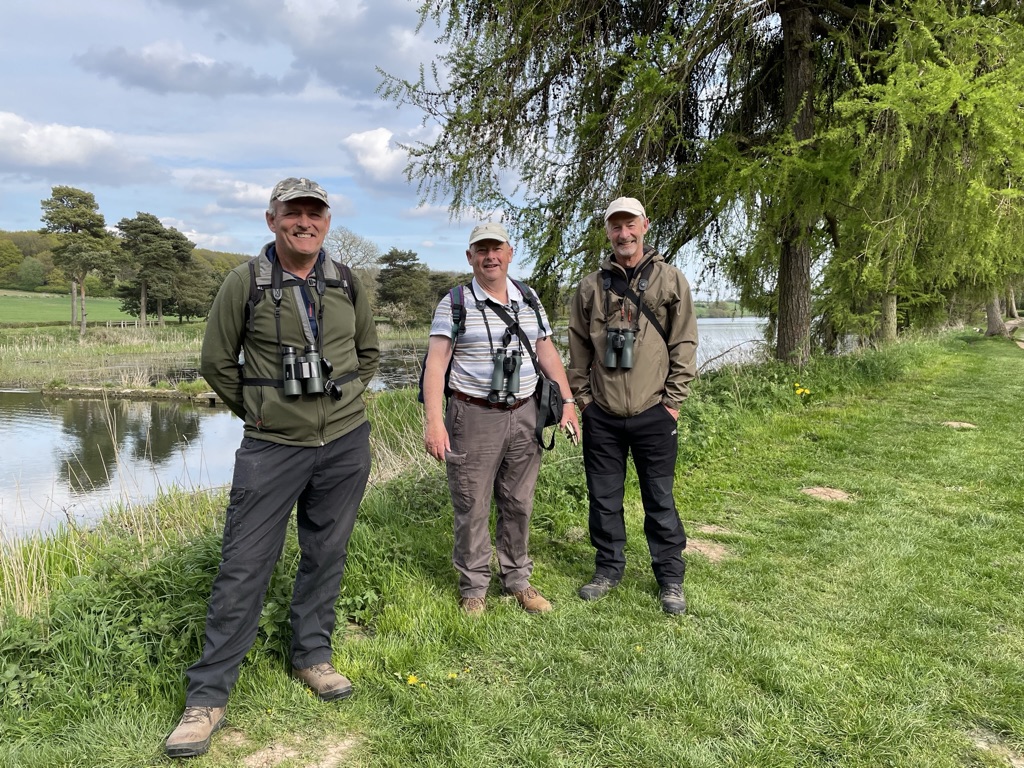
Andy accompanied us up through Browns Wood, where we were treated to a flock of 17 Yellowhammer flying through. Further into the wood, we had Long-tailed Tit and Jay and discovered a dead Pygmy Shrew amongst the grasses. Andy then pointed a couple of dew ponds in this delightful woodland before we parted company and pressed on to an un-named wood to the west of the M1. This also appeared to be part of the National Forest Tender Scheme and as we walked through this woodland, rich with native trees and blossom, we postulated that this could be a good site for Woodcock but were not aware of anyone surveying this area. We continued to cross a small stream, then passed under the motorway, the din of the traffic rendering birdsong almost impossible to hear in sharp contrast to our peaceful ramble so far. Just after the motorway, we caught sight of a magnificent Fox, its fur shining bright russet in the sunlight. Weaving our way through Markfield, the chatter of House Sparrow was unusually absent at first, prompting us to comment on the possible reasons for this, when they had been so prolific in every other village we had been through. Theories about differences in the surrounding habitat ensued until, on reaching the centre, their uplifting chirrups surrounded us once more and all was well with the World!
On the opposite side of the A50, we followed the path as it wound its way through a relatively young and extensive plantation, predominantly oak, before reaching higher ground with fine views over to the Charnwood hills. The distant sight of the Monument in Bradgate Park signalled that we were nearing the end of our journey and our feet were also telling us so by this stage too! We descended by the side of Cover Cloud Wood, carpeted in Bluebells and infused with the repeated, enthusiastic phrases of a Song Thrush. A series of paddocks presented the tantalising possibility of Wheatear and Ring Ouzel, recorded here in previous years, but sadly not on this occasion.
Our very last stretch took us through the centre of John Lee’s Wood, still alive with birdsong despite the late hour of 7:00pm! Nuthatch, Blackbird and Robin serenaded us, while yet more Bluebells and swathes of pure white Greater Stitchwort were a feast for the eyes as we continued to the outskirts of Newtown Linford. Passing the Bradgate and Linford Pubs with tongues hanging out by this stage, we pressed on with dogged determination to the main entrance of Bradgate Park, checking for Kingfisher on the River Lin as we went, and finally touched the iron gates of the Park where it had all began a month before.
The mellifluous tones of a blackbird in evening song hailed the end to our attempt to bird the Leicestershire Round. It had been a most memorable and enjoyable challenge, through sunshine and rain, mud and cold winds, but we were happy that we had managed to complete it to schedule, grateful to everyone who supported our endeavour and those who kept us company on the way round.
The day was rounded off with a meal in the Bradgate Arms, Cropston, mercifully only a few paces from our house, with Iain and Josh.
Special thanks go to all who have sponsored us to raise funds for LROS Conservation Projects. We have been very humbled by your generosity and support in making this whole event so worthwhile.
Our grateful thanks also go to Peter Williams and Pablo the dog, Josh Sollitt, David Whittle, Bruce White, Andrew Blackford, Chris and Kathy Payne, Andrew Cliff, Dave Wright and Julie and Andy Smith for their fantastic company en route. Iain Tidmarsh also deserves a special mention for his kindness in chauffeuring us to Shackerstone for the last leg and making sure that Josh made it to the right pub after work! The opportunity to spend some quality time with friends and doing what we love best in the great outdoors has been a truly wonderful experience and one which we will always hold very close to our hearts.
Now – where is that *** Kingfisher hiding???!!!………….
